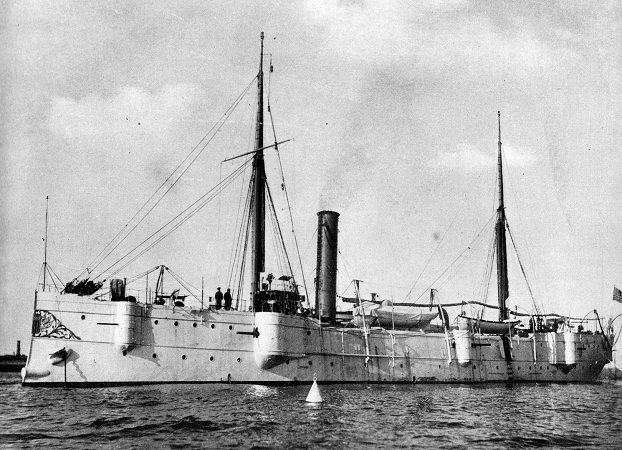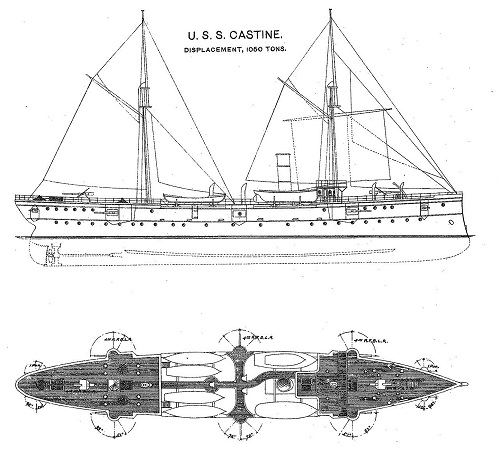

by Patrick McSherry

The Patrol Gunboat U.S.S. CASTINE This photo was
apparently taken before her length was extended and her stack
shortened.
The CASTINE was launched on May 11, 1892 by the Bath Iron Works of
Bath, Maine and was commissioned two and a half years later on October
22, 1894. She was commissioned under the command of Commander T. Perry.
CASTINE was assigned to the South Atlantic Squadron. She departed for
Pernambuco, Brazil by way of the Azores, Gibraltar, the Suez Canal and
around the Cape of Good Hope. With the sinking of the Battleship
MAINE in Havana harbor, CASTINE was ordered north and underwent a
brief overhaul in March 1898. She served in the blockade of Cuba and
apparently took part in the bombardment of San
Juan, Puerto Rico on May 12, 1898. During the action one of
boilers developed a leak and Boilermaker Evan Thomas Hunley actually had
to crawl within the boiler to make the repair during the fight. CASTINE
was one of the vessels that escorted the the fleet
of Army transports taking the U.S. Army's Fifth
Corps to Cuba. She served off Havana, Bahia Honda, and Guantanamo
Bay. In July, 1898 CASTINE joined the U.S.S. HAWK in sinking a blockade
runner, the ALFONSO XII, and shelling a nearby fort at Mariel, Cuba.
HAWK's guns did not have the range to damage the vessel which had run
aground and her cargo of ammunition, weapons, etc., was being unloaded.
CASTINE fired upon the merchantman, which exploded. The CASTINE also
fired on several gunboats that had some out to aid the merchantman,
which were driven back. in another action CASTINE evacuated the
Americans from the island of Navassa, located south of Cuba, who were
concerned about a Spanish attack.
Following the armistice, CASTINE steamed for Hampton Roads, Virginia and then Provincetown and Boston, Massachusetts. She apparently remained in the Boston area until the war ended with the Treaty of Paris on December, 10, 1898. She was then ordered to the Philippines by way of the Suez Canal where she supported the U.S. Army during its actions in the Philippine American War. She operated around the southern Islands of the archipelago, and was in charge of the evacuation from Zamboanga in 1899. CASTINE remained in the Far East until 1901, in which year she returned to the U.S. again via the Suez Canal.
CASTINE was decommissioned at Philadelphia on October 8, 1901 and was
recommissioned two years later in November, of 1903. CASTINE then served
in in the South Atlantic, the Caribbean and the Mediterranean until
being again decommissioned in 1905 at Portsmouth, New Hampshire.
She remained out of commission until 1908. Between 1908 and 1913 she
served as a submarine tender. With the outbreak of World War One she
served in the Caribbean, cruising off Mexico. In August of 1917 she was
ordered to Gibraltar and the Mediterranean. She remained there until the
conclusion of the war, and then returned to the U.S., and was
decommissioned for the last time at New Orleans on August 28, 1919.
CASTINE was sold on August 5, 1921.
The vessel carried a full schooner sail rig, meaning that she was
not truly designed to be fully part of the modern steam navy. To man
the sails, she likely had to carry additional crew for that purpose.
Her initial design provided for relatively small coal bunkers, limiting her range. However it was discovered that the ships of the MACHIAS Class, including the CASTINE had stability issues. To resolve the issue, the CASTINE was removed from the water, literally cut in half and had a fourteen foot section added. Also, armor was removed from the gun sponsons. Additional ballast was added forward, and the height of her stack and masts were also reduced. Because the section added amidships housed mainly coal bunkers, the work not only increased her stability but also her cruising range.
The gun sponsons that protruded from the side of the ship would
have made coaling at sea difficult.
Her battery was significantly large for a ship of her size.

| Classification: | Machias Class Gunboat | |
| Keel Laid: | May 11, 1892 | |
|---|---|---|
| Launched: | December 23, 1896 | |
| Commissioned: | October 22, 1894 | |
| Rig: | Schooner | |
| Armament: | Eight 4-inch rapid-fire guns | |
| Four 6-pounder rapid fire guns | ||
| Two 1-pounder rapid-fire guns | ||
| One Colt machine gun | ||
| 1 Field Gun |
||
| Contractor: | Bath Iron Works, Bath, Maine | |
| Cost: |
$318,500 |
|
| Length: | 204 feet | |
| Beam: | 32 feet, 1 1/2 inches | |
| Mean draft: | 12 feet | |
| Max. draft fully loaded: | 14 feet, four inches | |
| Displacement: | 1,177 tons | |
| Complement: | 11 Officers and 140 enlisted men | |
| Engine type: | Vertical triple expansion engines, generating 2,199 hp.; Twin screws | |
| Boiler type: | Two Marine Locomotive | |
| Speed: | 16.03 knots | |
| Coal bunker capacity: | 292.6 tons | |
| Endurance @ 10 knots: | 5,008 nautical miles |
Below is a list of officers, sailors and Marines assigned to the USS CASTINE.
Alden, John D., The American Steel Navy. (Annapolis: Naval Institute Press, 1972) 39, 377.
"A Royal Welcome," Evening Express
(Portland, Maine). September 2, 1898, p. 1.
Clerk of Joint Committee on Printing, The Abridgement of Message from the President of the United States to the Two Houses of Congress. (Washington: Government Printing Office, 1899). Vol. 2 1188-1191, 1248-1249; Vol. 4, 252, 266.
Dictionary of American Naval Fighting Ships. Vol.2 (Washington: Naval Department, 1963) 50.
"Hero of the Gunboat Castine," Boston Evening Transcript (Boston, MA). September 15, 1898. p. 12.
"Letter from Lester Street," Dixon Evening
Telegraph (Dixon, Illinois). July 18, 1898, p. 4.
Report of the Chief of the Bureau of Navigation. (Washington: Government Printing Office, 1898) 15-16.
"Ships and Men," Boston Globe (Boston,
Massachusetts). September 2, 1898, p. 5
"Spanish Merchantman Sunk," Leavenworth Times (Leavenworth, Kansas). July 10, 1898, p. 1.
Weaver, Barry, Col Albert F. Gleim and Danny
J. Farak, The West Indies Naval Campaign Medal of 1898 - The
Sampson Medal, the Ships and Men. (Arlington, VA: Planchet
Press, 1986) (data contributed by Douglas Davis).